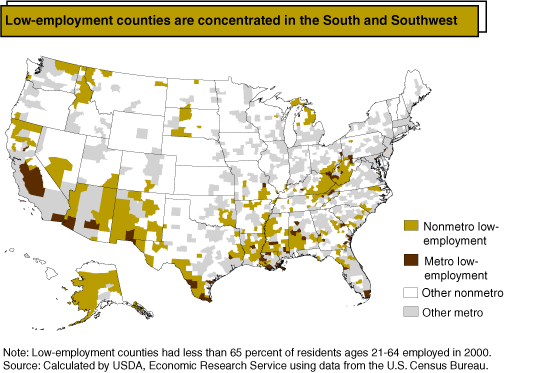Low Earnings But Steady Job Growth in Low-Employment Counties
- by Timothy Parker and Robert Gibbs
- 9/1/2005
The 2000 employment rate of working-age adults was near its historic high due to the robust U.S. economy and continued increases in educational attainment and women's labor force participation. Nearly 3 of 4 U.S. adults ages 21-64 held a job in 2000 (72.8 percent). In 460 counties defined as low-employment counties, employment rates were below 65 percent. These counties, mostly nonmetro (rural), have economies with below-average capacity for generating jobs and draw less than the average number of adults into the labor market than other counties. Improved educational and job training opportunities in conjunction with job creation strategies may raise the employment rate in these counties.
ERS's low-employment counties are found primarily in southern Appalachia, the Mississippi Delta, and other Black Belt areas in the South; Indian and Hispanic areas of the Southwest; and timber and agricultural areas of the Northwest. Over half of all low-employment counties also have low educational levels or persistent poverty.
Many low-employment counties have experienced sluggish long-term job growth as technological change and geographic shifts in production have reduced the demand for labor in agriculture, mining, and manufacturing. In a few cases, a sudden loss of jobs due to events such as plant closings has led to high unemployment rates. Overall job growth in low-employment counties has been steady, although slower than the nonmetro average growth.
Nonmetro low-employment counties had lower earnings per job in 2000 ($23,623) than all other nonmetro counties ($25,129). Low wages reduce the incentive to enter the labor market, especially among adults in families that require child care. Low-employment counties also have a higher proportion of households headed by single women and a higher share of married-couple families with a single wage earner, usually the husband. Low educational levels further limit opportunities for higher earnings and stable employment. These labor force characteristics are especially associated with lower employment rates among minorities, although rates for non-Hispanic Whites in low-employment counties are also lower than in other nonmetro counties.
This article is drawn from:
- County Typology Codes. (n.d.). U.S. Department of Agriculture, Economic Research Service.


